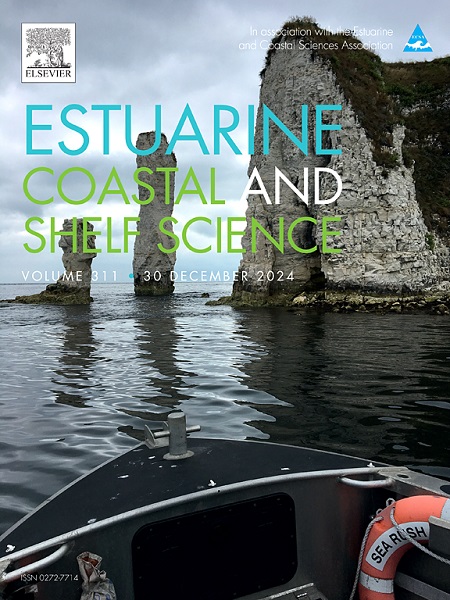Erosion threshold of cohesive sediments in the German Wadden Sea: Temporal variability and comparison of in-situ and laboratory experiments
IF 2.6
3区 地球科学
Q1 MARINE & FRESHWATER BIOLOGY
引用次数: 0
Abstract
A newly developed in-situ setup of the Closed Gust Erosion Microcosm System (C-GEMS) was utilized for erosion experiments in a tidal mudflat in the mouth of the Elbe in the German Wadden Sea to investigate the temporal variability of the erosion threshold of cohesive sediments. In addition, erosion experiments with extracted sediment cores from the same site were conducted in the field and in the laboratory with the identical device to analyze the influence of sample extraction and transport on the derived erosion threshold. A total of 21 erosion experiments were carried out in four measuring campaigns between April and September 2024. The erosion thresholds derived from the in-situ experiments exhibit considerable temporal variability across campaigns, with values of = 0.1–0.27 N/m2, while repeated experiments within the individual campaigns demonstrate a high degree of reproducibility. Accompanying analyses of surface sediment particle size distribution and bulk density revealed that mud concentration (clay and silt) varied with wind conditions and the associated hydrodynamic load prior to the measurement campaigns. The observed temporal variability in is reasonably well captured by a mathematical model based on mud concentration and particle size, suggesting that can be plausibly estimated from these parameters. For campaigns with a cohesive surface sediment layer, erosion thresholds derived in the ex-situ experiments are consistently lower than those obtained in the in-situ experiments. This is attributed to the disturbance of the surface sediments due to mechanical extraction and liquefaction during transport. The findings offer insights into the transport dynamics of cohesive sediments and help guide decisions on whether future erosion experiments should be conducted in situ, despite the significant effort involved, or whether extracted sediment cores are a suitable alternative.
德国瓦登海粘性沉积物的侵蚀阈值:时间变化和现场和实验室实验的比较
在德国瓦登海易北河河口潮汐滩涂进行了原位封闭阵风侵蚀微观系统(C-GEMS)的侵蚀实验,研究了粘性沉积物侵蚀阈值δ c的时间变化规律。此外,利用同一地点提取的岩心进行了现场和实验室侵蚀实验,采用相同的装置分析了样品提取和搬运对导出的侵蚀阈值的影响。在2024年4月至9月的4次测量活动中,共进行了21次侵蚀试验。从原位实验中得出的侵蚀阈值在不同运动中表现出相当大的时间变异性,其值τc = 0.1-0.27 N/m2,而在单个运动中的重复实验显示出高度的可重复性。对地表沉积物粒度分布和体积密度的分析表明,在测量活动之前,泥浆浓度(粘土和淤泥)随风条件和相关的水动力载荷而变化。基于泥浆浓度和粒度的数学模型可以很好地捕捉到观测到的τc的时间变化,这表明τc可以从这些参数中合理地估计出来。对于具有黏性表层沉积物的运动,离地试验得出的侵蚀阈值始终低于原位试验得到的值。这是由于运输过程中机械提取和液化对地表沉积物的扰动造成的。这些发现提供了对粘性沉积物的运移动力学的见解,并有助于指导决定未来的侵蚀实验是否应该在现场进行,尽管需要付出巨大的努力,或者提取沉积物岩心是否是一个合适的选择。
本文章由计算机程序翻译,如有差异,请以英文原文为准。
求助全文
约1分钟内获得全文
求助全文
来源期刊
CiteScore
5.60
自引率
7.10%
发文量
374
审稿时长
9 months
期刊介绍:
Estuarine, Coastal and Shelf Science is an international multidisciplinary journal devoted to the analysis of saline water phenomena ranging from the outer edge of the continental shelf to the upper limits of the tidal zone. The journal provides a unique forum, unifying the multidisciplinary approaches to the study of the oceanography of estuaries, coastal zones, and continental shelf seas. It features original research papers, review papers and short communications treating such disciplines as zoology, botany, geology, sedimentology, physical oceanography.

 求助内容:
求助内容: 应助结果提醒方式:
应助结果提醒方式:


